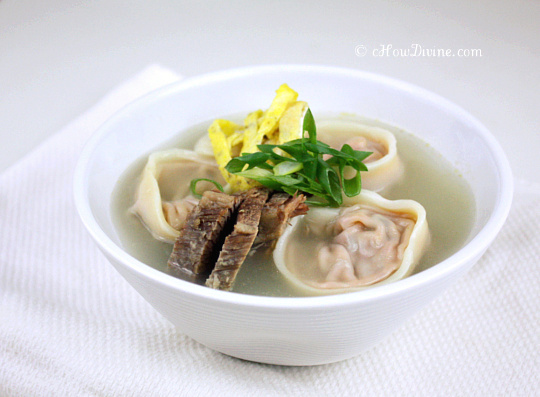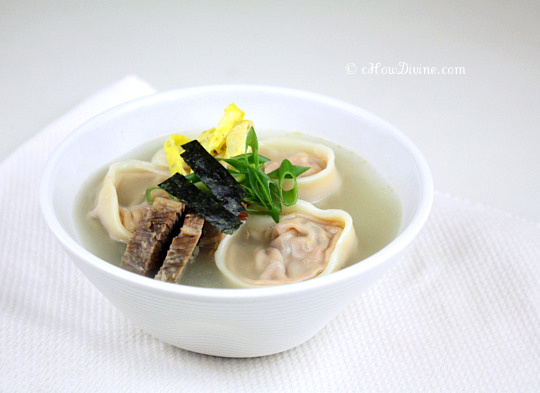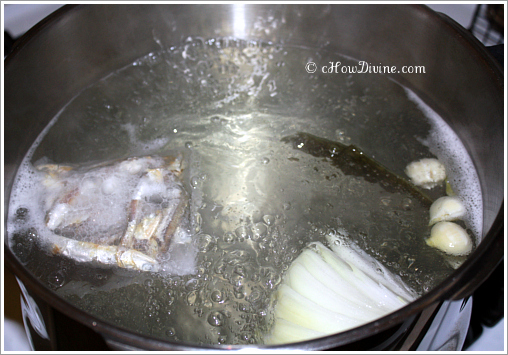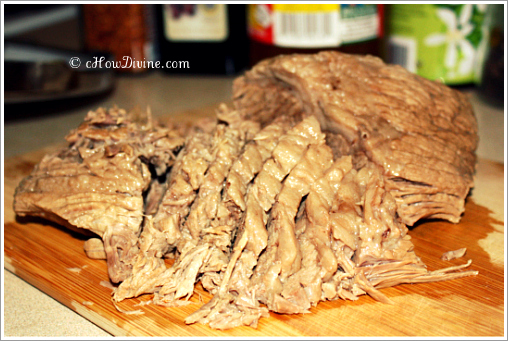
My grandmother used to tell me that I couldn’t ring in the New Year without having some Tteok Manduguk (Korean Rice Cake and Dumpling Soup) according to Korean tradition. Who am I to argue with this long-standing tradition?
I’ve been eating Tteok Manduguk on New Year’s Day as far back as I can remember. When I was young, my grandmother made EVERYTHING from scratch: the filling, the mandu skin, and the broth. I don’t have the luxury of my grandmother’s cooking anymore – haven’t for a few years now. But I still consume tons of the soup come every New Year’s Day, usually at a restaurant.
We could have gone to a Korean restaurant again this year, or I could have bought some frozen mandu and beef broth to whip up something quickly at home. But I love Korean soups made with homemade brisket broth. So I decided to strike a happy medium: buy some MSG-free mandu from a Korean market and make my own brisket broth. FYI, Pulmuone makes pretty good mandu free of MSG.
The brisket broth can be made by simply simmering brisket in water and adding some fish sauce; but you should really take the extra step of boiling some dried anchovies and dashima (in place of fish sauce) before simmering the brisket. This extra step makes the broth so much richer and more complex. It’s so worth the extra 15-20 minutes. To make it worth your while, you can make tons of broth and reserve any unused portion for later use. Just refrigerate it for short term use and freeze the rest. You can also make the broth in advance and skim off any fat that forms as it cools. I did just that: made tons of broth in advance and skimmed off the fat.
The broth was unbelievably rich and delicious. Throw in some mandu and tteok. And top it with whatever you want: scallions, sliced brisket, sliced egg crepe, toasted laver, or nothing at all. It just doesn’t compare to what you get at a run-of-the-mill Korean restaurant. I’m so glad I decided to make Tteok Manduguk at home. It was a resounding success!
Mandu Guk (Korean Dumpling Soup) Recipe
Ingredients
8 cups brisket stock: recipe follows immediately
3-4 slices brisket, per bowl
12 mandu (MSG-free, store-bought Korean dumplings)
2 cups tteok (sliced rice cakes)
2 eggs
1 sheet toasted laver, cut into thin strips or crushed
scallions, sliced thinly
salt & pepper
Note: pre-made mandu and tteok are readily available at most Korean grocers.
- Soak tteok in cold water (about 15-30 minutes). Soaking the tteok will make the tteok softer. Bring 8 cups brisket broth to a boil.
- While waiting for the broth to come to a boil, crack the eggs into a bowl. Mix with a fork. Stir in a dash of salt and pepper. Heat a pan over medium heat. Add enough oil to coat the bottom of the pan. Pour the egg mixture into the pan. Swirl the pan to make a thin crepe. Once the egg sets, flip it over on to the other side using a wide spatula. Let it cook on the other side. Remove from heat. Slice the cooked egg thinly. Set it aside.
- Once the broth comes to a boil, add 1/2 tsp salt, mandu and drained tteok to the pot. Let the contents come to a boil. Lower the heat. Let it cook for about 10 minutes, until the rice cakes are soft and chewy, and mandu is cooked through. Use caution when stirring. Mandu may break open if stirred too roughly.
- Divide the soup into bowls. Add sliced brisket, chopped scallions, sliced egg crepe and/or toasted laver. Add salt and pepper to taste. As always, taste test first before adding additional salt. Personally, I didn’t need additional salt. Serve while the soup is hot.
Brisket Stock (Soup Base)
Ingredients
23 cups water (about 1 1/2 gallon)
2 lbs brisket
10-15 large dried anchovies
2″-3″ kombu
4-5 garlic cloves
1/4 onion
salt & pepper
tamari (gluten-free soy sauce)
- Add brisket to a large bowl of cold water. Soak for 45 minutes – 1 hour. This will draw out some blood from the brisket. This is a common practice in Korean cooking when boiling or braising beef in liquid. It is thought to remove any undesired odor or flavor associated with boiled or braised beef.
- Add about 1 1/2 gallons water, onion, garlic cloves, and kombu to a large pot. When it comes to a boil, add dried anchovies. Let it boil for 15 minutes. Take the anchovies and kombu out of the pot using a slotted spoon.
- Take the brisket out of the soaking water. Carefully add brisket to the boiling stock. Let it come to a boil again. Lower the heat and let it simmer for at least 2 hours, until the meat is cooked through and very tender.** You can add additional water as needed to replace liquid lost through vaporization.
- Discard garlic and onion with a slotted spoon. Take the brisket out of the stock. Cut only the portion of the cooked brisket that you plan to use. Any unused brisket can be reserved/refrigerated for later use. The meat should be good for a few days in the refrigerator. The leftover meat can be “refreshed” by simmering it in broth for a few minutes.
- Slice the brisket thinly against the grain. The sliced brisket can be added to soups directly unseasoned. You can also season it by adding a dash of salt, pepper, and tamari. Mix gently. In addition to use in soups, the seasoned meat can be enjoyed on its own while its still warm; try it with some rice or noodles.
- Refrigerate or freeze any unused stock for future use.
** You can cut down the cooking time significantly by using a pressure cooker. I used a pressure cooker for this step and cooked the brisket under pressure for about 30 minutes. The stock was extremely flavorful. Additionally, you don’t lose much stock through vaporization.





it sounds quite different from what I’m used to but it looks fantastic!
Thanks Beti! It’s really savory and comforting. I hope you give it try!
Oh this looks amazing! I wish I have it right now to warm me up…but will think about this soup while eating kimchi ramen with extra slice of cheese 🙂
Happy New Year, I wish you all the best!!!!
Thank you Sandra! I’m telling you, we must be related somewhere up in the family tree. That’s exactly how my family used to eat ramen when I was growing up! 😀 It’s so yummy when the cheese just starts to melt and get gooey! I can’t do it anymore on account of my lactose intolerance getting worse. 🙁 But you can enjoy it for the both of us! Happy New Year; I wish you all the happiness!
Hello & thank you for posting such great recipes. I’ve been married to my husband (Korean) for 16 years. Up until mid 2012, I had never tried cooking anything Korean. I asked Halmony (his mom) to show me many times, but it never really happened. Mainly because she does everything by sight or taste so it’d be hard to translate into measurement. Then there’s also the language barrier. So in 2012 I figured I’ve got nothing to lose. So I scoured the Internet to find some great recipes for my favorite food. I love your ssamjang recipe. I love spicy! So tonight I made your tteok mandoo guk. It was absolutely delicious. The only thing I’m missing is the spicy sauce. When I’ve had Halmony’s or restaurant mandoo guk there is a spicy sauce that I enjoy mixing in. It is thinner than the ssamjang & has sesame seeds (or maybe they’re chili seeds or both). I’ve looked for a recipe, but I don’t know what it’s called. Thank you so much.
Thank you for coming by the site Stephanie! I’m so glad you enjoyed the tteok manduguk. And thank you so much for your kind words.
I think you are talking about the spicy soy sauce that is used for the mandu. Was it a little a vinegary too? You don’t need to add the vinegar, but I prefer it. Just mix 1 part rice vinegar, 2 parts soy sauce, toasted sesame seeds, Korean chili pepper flakes, and minced garlic. You can also stir in some chopped green onions.
If you want to see a complete recipe, here is a dipping sauce that is similar to this sauce. Just scroll down to the bottom of the page for the sauce.